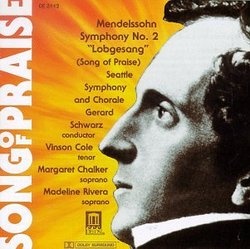| All Artists: Mendelssohn, Schwarz, Seattle Symphony Title: Lobgesang Members Wishing: 0 Total Copies: 0 Label: Delos Records Release Date: 8/2/1994 Genre: Classical Style: Symphonies Number of Discs: 1 SwapaCD Credits: 1 UPC: 013491311227 |
Search - Mendelssohn, Schwarz, Seattle Symphony :: Lobgesang
 | Mendelssohn, Schwarz, Seattle Symphony Lobgesang Genre: Classical
|
Larger Image |
CD Details |
CD ReviewsGreat Symphonic Work, OK Chorus Brett A. Kniess | Madison, WI | 01/06/2006 (3 out of 5 stars) "Mendelssohn's Symphony No. 2, subtitled Lobgesang or Hymn of Praise, was written for a festival in Leipzig for the 400th anniversary of Johannes Gutenberg's invention of the printing press. Equally important, in Mendelssohn's mind for this composition, was the subsequent publication of the German translated Bible by Martin Luther, available to a larger population because of the invention. The work is Romantic, however, it is more properly termed Neo-Baroque, because of the inclusion of musical elements of J.S. Bach's time. While it is in a four-movement symphonic form, it is also in a ten-part cantata form as well. The first three purely instrumental movements form the introduction (or Sinfonia) to the nine-part choral/vocal cantata last movement. Mendelssohn received a lot of guff for writing a choral symphony after Beethoven's Symphony No. 9, especially in the Germanic countries (even though Berlioz already wrote symphonies with chorus by this time). It was well received, however, in England, and English performances are perfectly acceptable, although this recording is in German. Mendelssohn's own Jewish background is evident from the old testament-based texts, and his love of Bach is evident from the direct quote of his chorale, Nun danket alle Gott.
The Music: The trombones herald the opening with a theme that will reappear throughout the work. It starts majestic, but a more energetic section soon invades, with a leaping motive mixed with the earlier motive. The second movement, in a dance-like 6/8 time, show Mendelssohn's penchant for excellent melodic writing. A forlorn statement in violin/cello is taken over by oboe and bassoon; a lovely and moving section which is interrupted by a woodwind/brass chorale (based on the original motive) plays against the lilting strings. The third movement, marked Adagio religioso, begins with a chorale in strings, followed by winds alone. The rhythms pick up and the opening melody appears once more. All of the first three movements are played without break, making a case for one large introductory Sinfonia to the cantata. The 30-minute Sinfonia is thusly followed by a 40-minute cantata, complete with chorus, soloists, organ, and orchestra. As before, the opening theme is used a lot, and many Baroque techniques are employed, including choral fugues. The performers: The highlight of this disk is the Seattle Symphony under Gerard Schwarz. They have a lush, resonant sound and play with passion. The soloists are good as well; of note, the soprano duet is Part 5 is exceedingly beautiful. The tenor Vinson Cole is a lyric sounding tenor, usually too fluffy for my taste, but he works well here. The setback is the chorus. First, they could be placed closer, but the real problem is execution. The men give a floaty sound, a product of poor vocal technique (and really not exciting to listen to), often resulting in tuning issues, especially in high registers. It is a real shame, because all of the other elements are excellent. Recommendation: There are better recordings (because of the men's chorus). For a German version (like this one), Dohnanyi on Decca/London is the best choice (Symphony 1, 2, and a rousing cantata, all for the price of one CD), and I suppose the Karajan on DG, although I find it heavy-handed. For an English version, and as my personal favorite of all, is Sir Walter Weller on Chandos, a great performance. In any case, I suggest looking for something else, unless you can stand the chorus." |

 Track Listings (12) - Disc #1
Track Listings (12) - Disc #1